Assessment, Interprofessional Care and Public Health Strategies for Cancer Prevention and Control
VerifiedAdded on 2023/06/12
|6
|1568
|267
AI Summary
This article discusses the assessment process for chemotherapy-induced nausea and vomiting, interprofessional care for cancer patients, and public health strategies for cancer prevention and control. It includes two assessment tools for detecting CINV, the role of a dietician and support group carer in interprofessional care, and various public health strategies implemented by the Australian government. The article also includes references from various journals and websites.
Contribute Materials
Your contribution can guide someone’s learning journey. Share your
documents today.
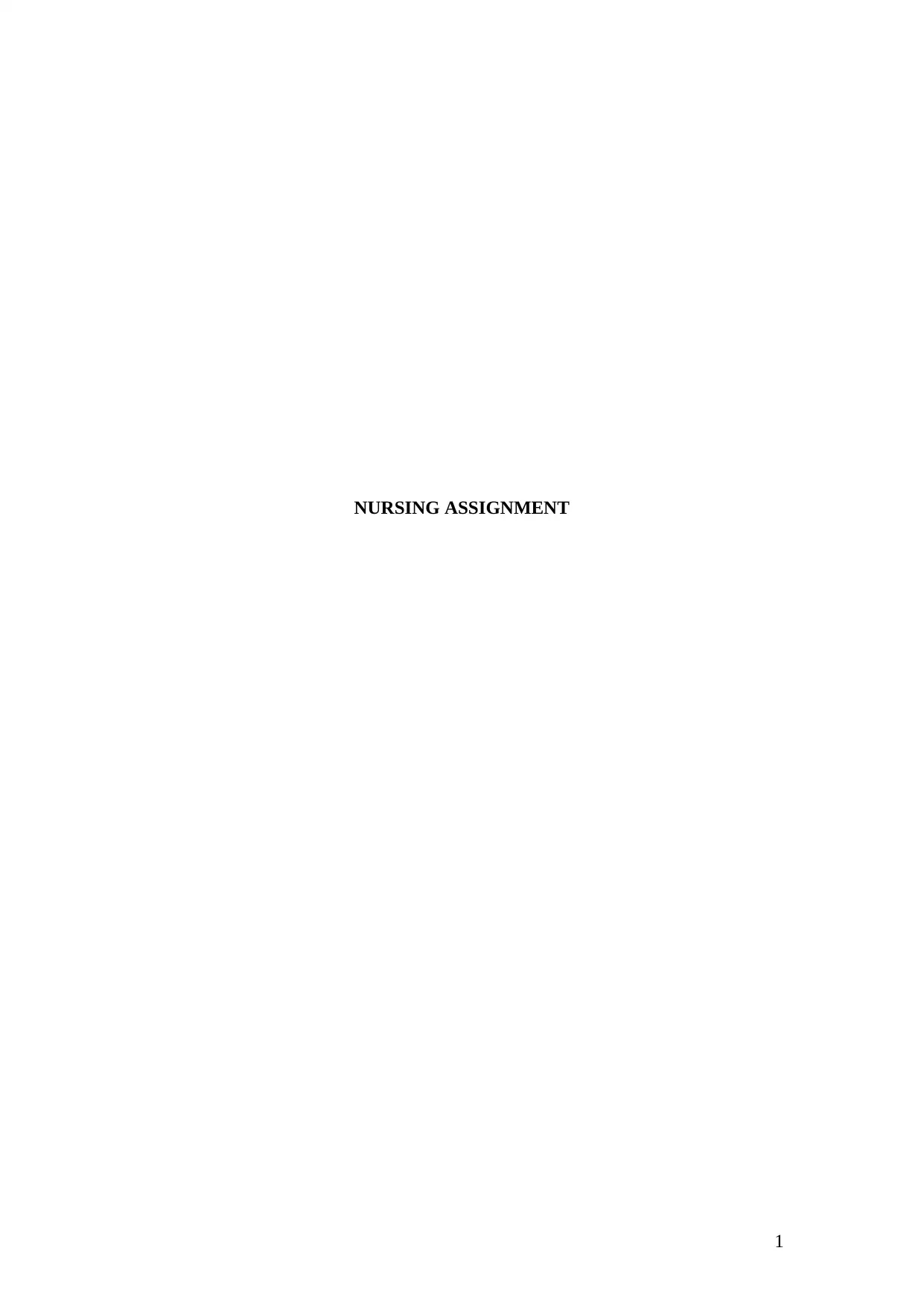
NURSING ASSIGNMENT
1
1
Secure Best Marks with AI Grader
Need help grading? Try our AI Grader for instant feedback on your assignments.
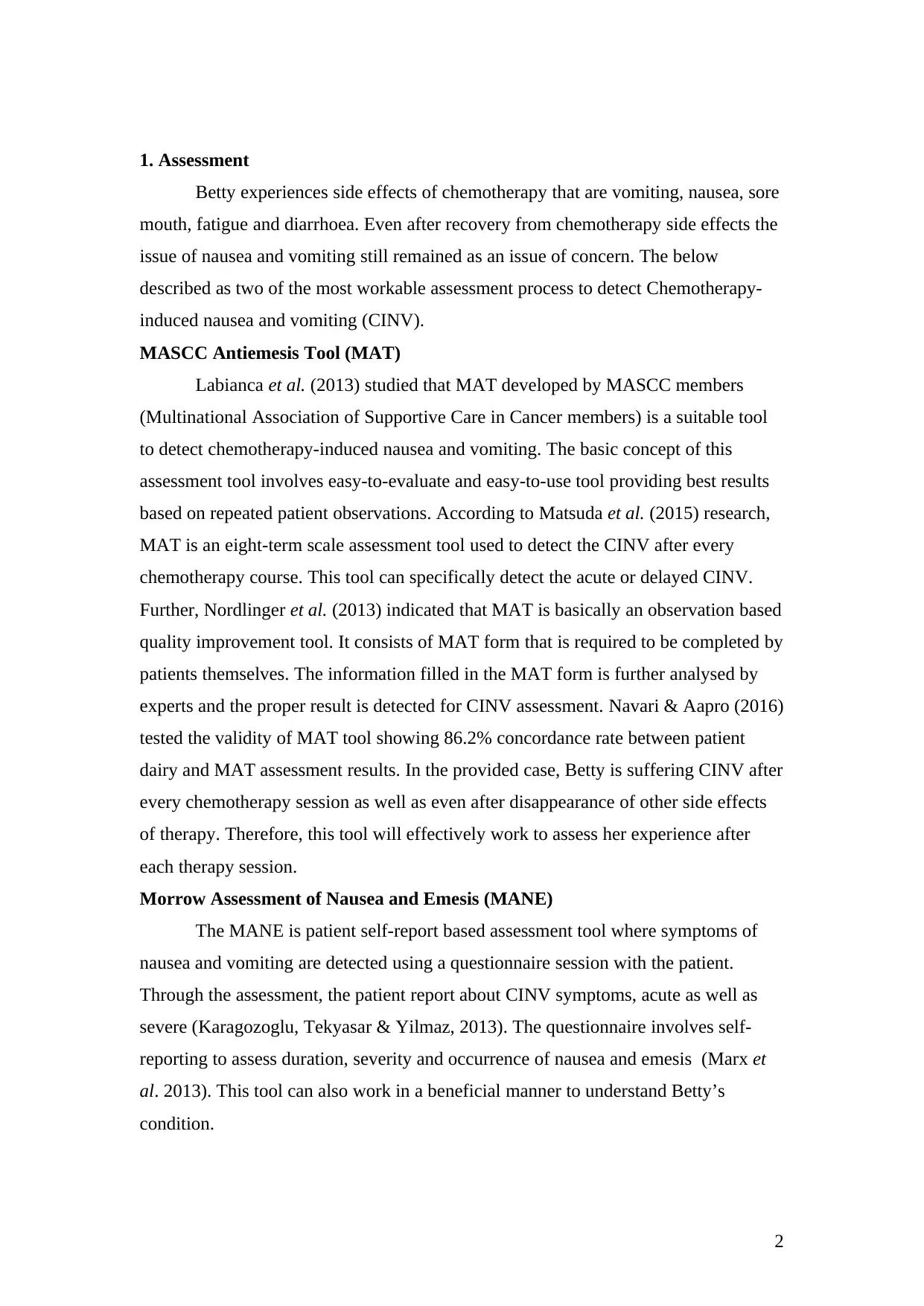
1. Assessment
Betty experiences side effects of chemotherapy that are vomiting, nausea, sore
mouth, fatigue and diarrhoea. Even after recovery from chemotherapy side effects the
issue of nausea and vomiting still remained as an issue of concern. The below
described as two of the most workable assessment process to detect Chemotherapy-
induced nausea and vomiting (CINV).
MASCC Antiemesis Tool (MAT)
Labianca et al. (2013) studied that MAT developed by MASCC members
(Multinational Association of Supportive Care in Cancer members) is a suitable tool
to detect chemotherapy-induced nausea and vomiting. The basic concept of this
assessment tool involves easy-to-evaluate and easy-to-use tool providing best results
based on repeated patient observations. According to Matsuda et al. (2015) research,
MAT is an eight-term scale assessment tool used to detect the CINV after every
chemotherapy course. This tool can specifically detect the acute or delayed CINV.
Further, Nordlinger et al. (2013) indicated that MAT is basically an observation based
quality improvement tool. It consists of MAT form that is required to be completed by
patients themselves. The information filled in the MAT form is further analysed by
experts and the proper result is detected for CINV assessment. Navari & Aapro (2016)
tested the validity of MAT tool showing 86.2% concordance rate between patient
dairy and MAT assessment results. In the provided case, Betty is suffering CINV after
every chemotherapy session as well as even after disappearance of other side effects
of therapy. Therefore, this tool will effectively work to assess her experience after
each therapy session.
Morrow Assessment of Nausea and Emesis (MANE)
The MANE is patient self-report based assessment tool where symptoms of
nausea and vomiting are detected using a questionnaire session with the patient.
Through the assessment, the patient report about CINV symptoms, acute as well as
severe (Karagozoglu, Tekyasar & Yilmaz, 2013). The questionnaire involves self-
reporting to assess duration, severity and occurrence of nausea and emesis (Marx et
al. 2013). This tool can also work in a beneficial manner to understand Betty’s
condition.
2
Betty experiences side effects of chemotherapy that are vomiting, nausea, sore
mouth, fatigue and diarrhoea. Even after recovery from chemotherapy side effects the
issue of nausea and vomiting still remained as an issue of concern. The below
described as two of the most workable assessment process to detect Chemotherapy-
induced nausea and vomiting (CINV).
MASCC Antiemesis Tool (MAT)
Labianca et al. (2013) studied that MAT developed by MASCC members
(Multinational Association of Supportive Care in Cancer members) is a suitable tool
to detect chemotherapy-induced nausea and vomiting. The basic concept of this
assessment tool involves easy-to-evaluate and easy-to-use tool providing best results
based on repeated patient observations. According to Matsuda et al. (2015) research,
MAT is an eight-term scale assessment tool used to detect the CINV after every
chemotherapy course. This tool can specifically detect the acute or delayed CINV.
Further, Nordlinger et al. (2013) indicated that MAT is basically an observation based
quality improvement tool. It consists of MAT form that is required to be completed by
patients themselves. The information filled in the MAT form is further analysed by
experts and the proper result is detected for CINV assessment. Navari & Aapro (2016)
tested the validity of MAT tool showing 86.2% concordance rate between patient
dairy and MAT assessment results. In the provided case, Betty is suffering CINV after
every chemotherapy session as well as even after disappearance of other side effects
of therapy. Therefore, this tool will effectively work to assess her experience after
each therapy session.
Morrow Assessment of Nausea and Emesis (MANE)
The MANE is patient self-report based assessment tool where symptoms of
nausea and vomiting are detected using a questionnaire session with the patient.
Through the assessment, the patient report about CINV symptoms, acute as well as
severe (Karagozoglu, Tekyasar & Yilmaz, 2013). The questionnaire involves self-
reporting to assess duration, severity and occurrence of nausea and emesis (Marx et
al. 2013). This tool can also work in a beneficial manner to understand Betty’s
condition.
2
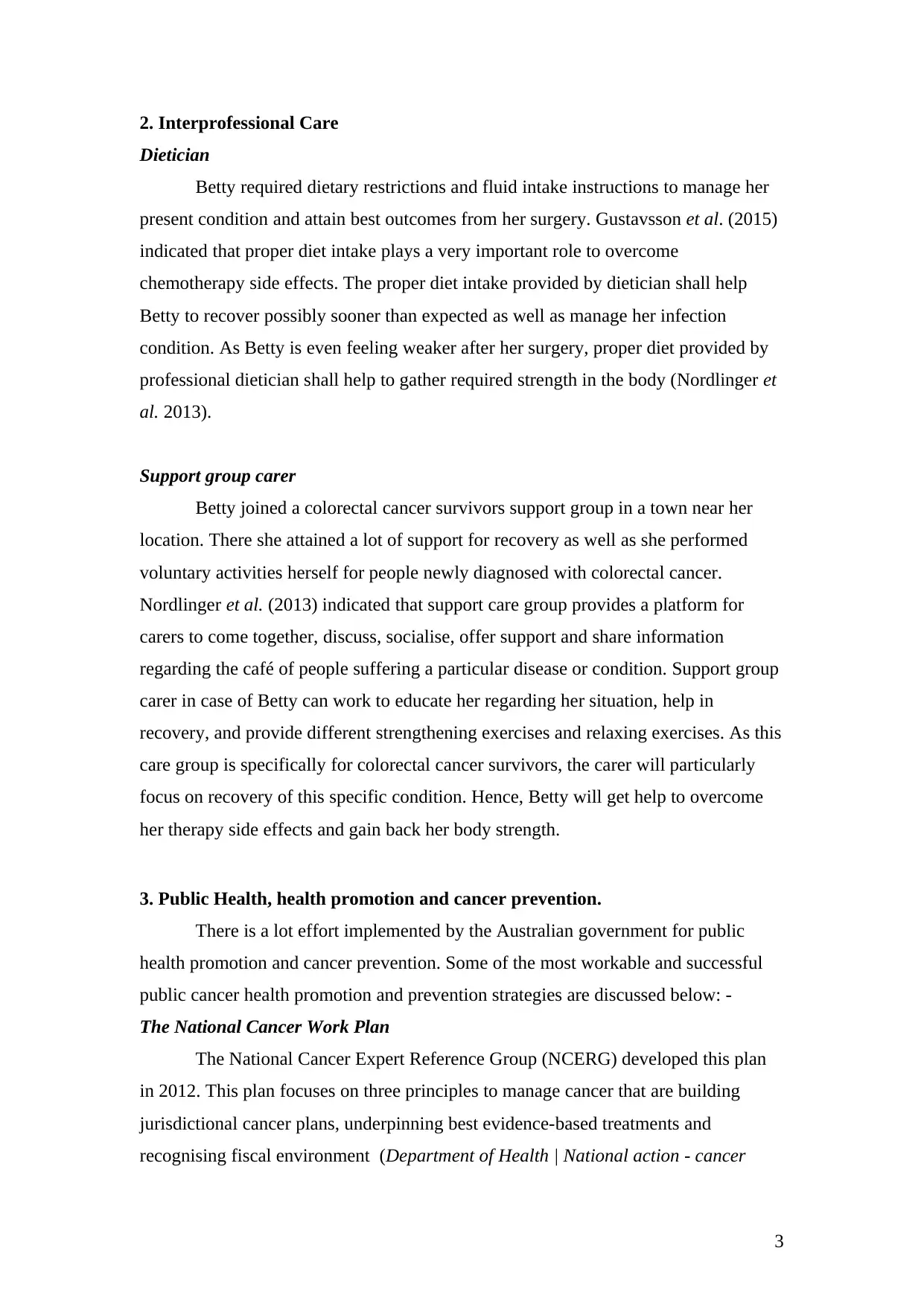
2. Interprofessional Care
Dietician
Betty required dietary restrictions and fluid intake instructions to manage her
present condition and attain best outcomes from her surgery. Gustavsson et al. (2015)
indicated that proper diet intake plays a very important role to overcome
chemotherapy side effects. The proper diet intake provided by dietician shall help
Betty to recover possibly sooner than expected as well as manage her infection
condition. As Betty is even feeling weaker after her surgery, proper diet provided by
professional dietician shall help to gather required strength in the body (Nordlinger et
al. 2013).
Support group carer
Betty joined a colorectal cancer survivors support group in a town near her
location. There she attained a lot of support for recovery as well as she performed
voluntary activities herself for people newly diagnosed with colorectal cancer.
Nordlinger et al. (2013) indicated that support care group provides a platform for
carers to come together, discuss, socialise, offer support and share information
regarding the café of people suffering a particular disease or condition. Support group
carer in case of Betty can work to educate her regarding her situation, help in
recovery, and provide different strengthening exercises and relaxing exercises. As this
care group is specifically for colorectal cancer survivors, the carer will particularly
focus on recovery of this specific condition. Hence, Betty will get help to overcome
her therapy side effects and gain back her body strength.
3. Public Health, health promotion and cancer prevention.
There is a lot effort implemented by the Australian government for public
health promotion and cancer prevention. Some of the most workable and successful
public cancer health promotion and prevention strategies are discussed below: -
The National Cancer Work Plan
The National Cancer Expert Reference Group (NCERG) developed this plan
in 2012. This plan focuses on three principles to manage cancer that are building
jurisdictional cancer plans, underpinning best evidence-based treatments and
recognising fiscal environment (Department of Health | National action - cancer
3
Dietician
Betty required dietary restrictions and fluid intake instructions to manage her
present condition and attain best outcomes from her surgery. Gustavsson et al. (2015)
indicated that proper diet intake plays a very important role to overcome
chemotherapy side effects. The proper diet intake provided by dietician shall help
Betty to recover possibly sooner than expected as well as manage her infection
condition. As Betty is even feeling weaker after her surgery, proper diet provided by
professional dietician shall help to gather required strength in the body (Nordlinger et
al. 2013).
Support group carer
Betty joined a colorectal cancer survivors support group in a town near her
location. There she attained a lot of support for recovery as well as she performed
voluntary activities herself for people newly diagnosed with colorectal cancer.
Nordlinger et al. (2013) indicated that support care group provides a platform for
carers to come together, discuss, socialise, offer support and share information
regarding the café of people suffering a particular disease or condition. Support group
carer in case of Betty can work to educate her regarding her situation, help in
recovery, and provide different strengthening exercises and relaxing exercises. As this
care group is specifically for colorectal cancer survivors, the carer will particularly
focus on recovery of this specific condition. Hence, Betty will get help to overcome
her therapy side effects and gain back her body strength.
3. Public Health, health promotion and cancer prevention.
There is a lot effort implemented by the Australian government for public
health promotion and cancer prevention. Some of the most workable and successful
public cancer health promotion and prevention strategies are discussed below: -
The National Cancer Work Plan
The National Cancer Expert Reference Group (NCERG) developed this plan
in 2012. This plan focuses on three principles to manage cancer that are building
jurisdictional cancer plans, underpinning best evidence-based treatments and
recognising fiscal environment (Department of Health | National action - cancer
3

control, 2018). The plan actions involve agreed cancer care pathways, efficient cancer
services and implementing cancer treatments (NSW 2012 and NSW cancer Plan
2011-15, 2012).
Strategic directions for cancer prevention and control 2009-2012
According to Gustavsson et al. (2015) studies about strategic directions for
cancer prevention and control 2009-2012 strategies that work to control key risk
factors causing cancer that are poor nutrition, smoking, alcohol misuse, physical
inactivity and carcinogenic exposures. The cancers covered under this strategy are
breast cancer, bowel cancer, cervical and skin cancer. Nordlinger et al. (2013)
indicated that skin and Bowel cancer are most common categories of cancer in
Australian public (Strategic directions for cancer prevention and control 2009-2012,
2018).
Education (Workplace Toolkit)
The Bowel Cancer Australian organisation has developed a workplace toolkit
to make its employee aware or educate about healthy eating, regular exercises,
limiting alcohol and quit smoking along with access to Bowel Cancer Screening
Program “Screen for life” (Education - Bowel Cancer Australia, 2018). This program
is now used by other organisation as a strategy to manage bowel cancer.
Health promotion campaigns
The health promotion campaign is one such popular strategy that works in a
very positive manner to study, diagnose and control cancer. In Australia, breast and
cervical cancer screening, immunisation, awareness weeks, coeliac awareness weeks,
National skin cancer action week etc. are some these cancer health promotion
campaigns (Practitioners, 2018).
4
services and implementing cancer treatments (NSW 2012 and NSW cancer Plan
2011-15, 2012).
Strategic directions for cancer prevention and control 2009-2012
According to Gustavsson et al. (2015) studies about strategic directions for
cancer prevention and control 2009-2012 strategies that work to control key risk
factors causing cancer that are poor nutrition, smoking, alcohol misuse, physical
inactivity and carcinogenic exposures. The cancers covered under this strategy are
breast cancer, bowel cancer, cervical and skin cancer. Nordlinger et al. (2013)
indicated that skin and Bowel cancer are most common categories of cancer in
Australian public (Strategic directions for cancer prevention and control 2009-2012,
2018).
Education (Workplace Toolkit)
The Bowel Cancer Australian organisation has developed a workplace toolkit
to make its employee aware or educate about healthy eating, regular exercises,
limiting alcohol and quit smoking along with access to Bowel Cancer Screening
Program “Screen for life” (Education - Bowel Cancer Australia, 2018). This program
is now used by other organisation as a strategy to manage bowel cancer.
Health promotion campaigns
The health promotion campaign is one such popular strategy that works in a
very positive manner to study, diagnose and control cancer. In Australia, breast and
cervical cancer screening, immunisation, awareness weeks, coeliac awareness weeks,
National skin cancer action week etc. are some these cancer health promotion
campaigns (Practitioners, 2018).
4
Secure Best Marks with AI Grader
Need help grading? Try our AI Grader for instant feedback on your assignments.
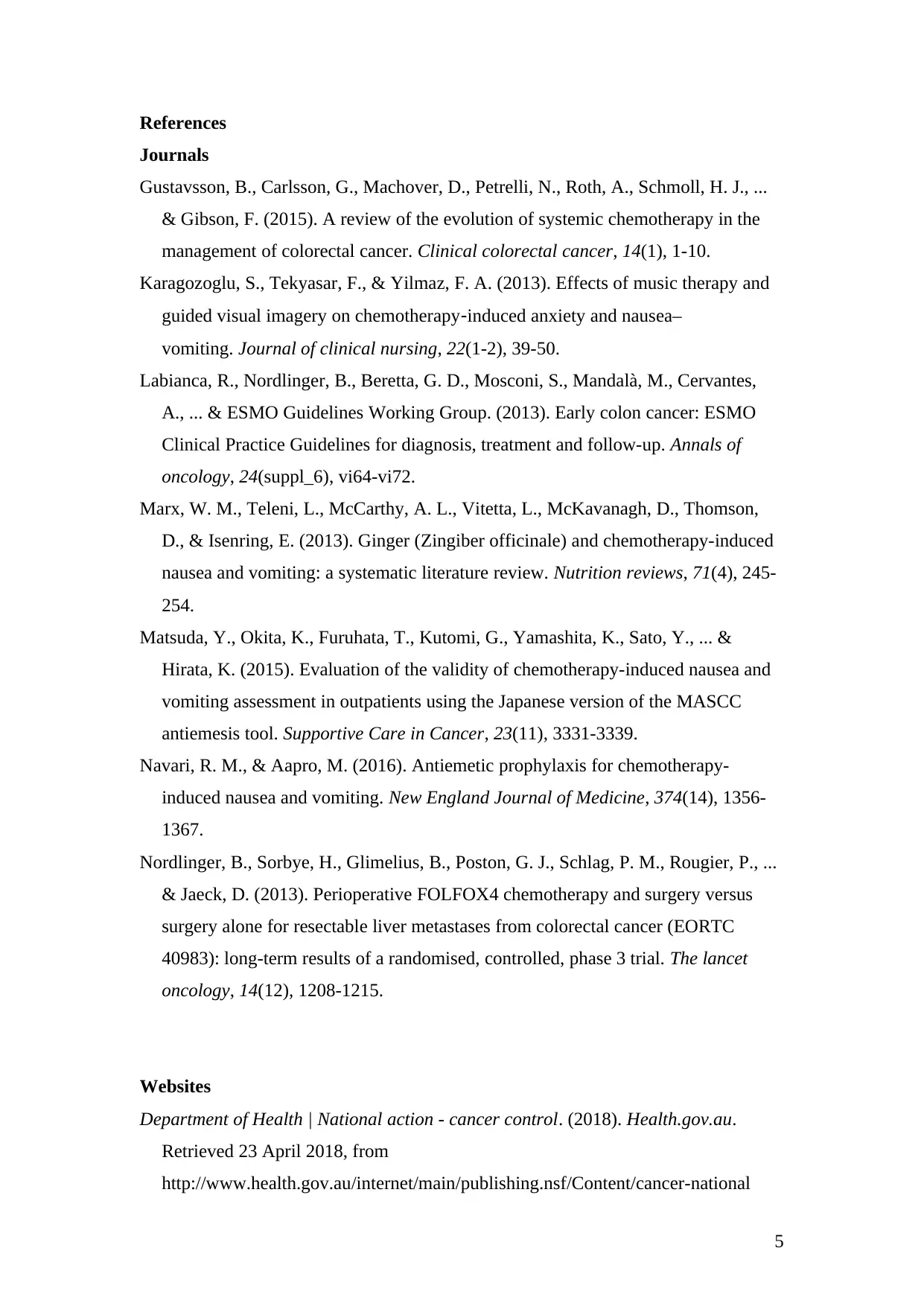
References
Journals
Gustavsson, B., Carlsson, G., Machover, D., Petrelli, N., Roth, A., Schmoll, H. J., ...
& Gibson, F. (2015). A review of the evolution of systemic chemotherapy in the
management of colorectal cancer. Clinical colorectal cancer, 14(1), 1-10.
Karagozoglu, S., Tekyasar, F., & Yilmaz, F. A. (2013). Effects of music therapy and
guided visual imagery on chemotherapy‐induced anxiety and nausea–
vomiting. Journal of clinical nursing, 22(1-2), 39-50.
Labianca, R., Nordlinger, B., Beretta, G. D., Mosconi, S., Mandalà, M., Cervantes,
A., ... & ESMO Guidelines Working Group. (2013). Early colon cancer: ESMO
Clinical Practice Guidelines for diagnosis, treatment and follow-up. Annals of
oncology, 24(suppl_6), vi64-vi72.
Marx, W. M., Teleni, L., McCarthy, A. L., Vitetta, L., McKavanagh, D., Thomson,
D., & Isenring, E. (2013). Ginger (Zingiber officinale) and chemotherapy-induced
nausea and vomiting: a systematic literature review. Nutrition reviews, 71(4), 245-
254.
Matsuda, Y., Okita, K., Furuhata, T., Kutomi, G., Yamashita, K., Sato, Y., ... &
Hirata, K. (2015). Evaluation of the validity of chemotherapy-induced nausea and
vomiting assessment in outpatients using the Japanese version of the MASCC
antiemesis tool. Supportive Care in Cancer, 23(11), 3331-3339.
Navari, R. M., & Aapro, M. (2016). Antiemetic prophylaxis for chemotherapy-
induced nausea and vomiting. New England Journal of Medicine, 374(14), 1356-
1367.
Nordlinger, B., Sorbye, H., Glimelius, B., Poston, G. J., Schlag, P. M., Rougier, P., ...
& Jaeck, D. (2013). Perioperative FOLFOX4 chemotherapy and surgery versus
surgery alone for resectable liver metastases from colorectal cancer (EORTC
40983): long-term results of a randomised, controlled, phase 3 trial. The lancet
oncology, 14(12), 1208-1215.
Websites
Department of Health | National action - cancer control. (2018). Health.gov.au.
Retrieved 23 April 2018, from
http://www.health.gov.au/internet/main/publishing.nsf/Content/cancer-national
5
Journals
Gustavsson, B., Carlsson, G., Machover, D., Petrelli, N., Roth, A., Schmoll, H. J., ...
& Gibson, F. (2015). A review of the evolution of systemic chemotherapy in the
management of colorectal cancer. Clinical colorectal cancer, 14(1), 1-10.
Karagozoglu, S., Tekyasar, F., & Yilmaz, F. A. (2013). Effects of music therapy and
guided visual imagery on chemotherapy‐induced anxiety and nausea–
vomiting. Journal of clinical nursing, 22(1-2), 39-50.
Labianca, R., Nordlinger, B., Beretta, G. D., Mosconi, S., Mandalà, M., Cervantes,
A., ... & ESMO Guidelines Working Group. (2013). Early colon cancer: ESMO
Clinical Practice Guidelines for diagnosis, treatment and follow-up. Annals of
oncology, 24(suppl_6), vi64-vi72.
Marx, W. M., Teleni, L., McCarthy, A. L., Vitetta, L., McKavanagh, D., Thomson,
D., & Isenring, E. (2013). Ginger (Zingiber officinale) and chemotherapy-induced
nausea and vomiting: a systematic literature review. Nutrition reviews, 71(4), 245-
254.
Matsuda, Y., Okita, K., Furuhata, T., Kutomi, G., Yamashita, K., Sato, Y., ... &
Hirata, K. (2015). Evaluation of the validity of chemotherapy-induced nausea and
vomiting assessment in outpatients using the Japanese version of the MASCC
antiemesis tool. Supportive Care in Cancer, 23(11), 3331-3339.
Navari, R. M., & Aapro, M. (2016). Antiemetic prophylaxis for chemotherapy-
induced nausea and vomiting. New England Journal of Medicine, 374(14), 1356-
1367.
Nordlinger, B., Sorbye, H., Glimelius, B., Poston, G. J., Schlag, P. M., Rougier, P., ...
& Jaeck, D. (2013). Perioperative FOLFOX4 chemotherapy and surgery versus
surgery alone for resectable liver metastases from colorectal cancer (EORTC
40983): long-term results of a randomised, controlled, phase 3 trial. The lancet
oncology, 14(12), 1208-1215.
Websites
Department of Health | National action - cancer control. (2018). Health.gov.au.
Retrieved 23 April 2018, from
http://www.health.gov.au/internet/main/publishing.nsf/Content/cancer-national
5
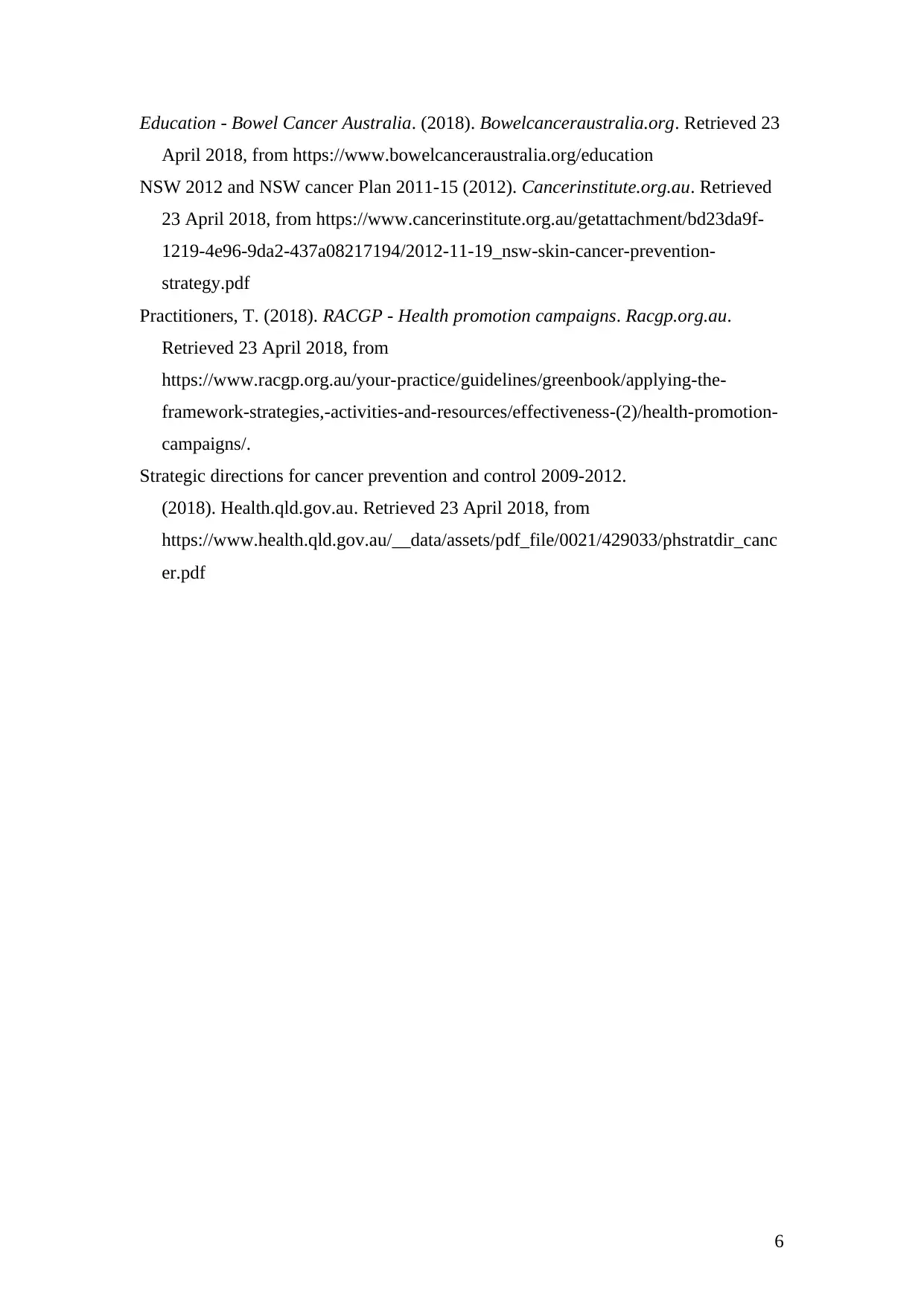
Education - Bowel Cancer Australia. (2018). Bowelcanceraustralia.org. Retrieved 23
April 2018, from https://www.bowelcanceraustralia.org/education
NSW 2012 and NSW cancer Plan 2011-15 (2012). Cancerinstitute.org.au. Retrieved
23 April 2018, from https://www.cancerinstitute.org.au/getattachment/bd23da9f-
1219-4e96-9da2-437a08217194/2012-11-19_nsw-skin-cancer-prevention-
strategy.pdf
Practitioners, T. (2018). RACGP - Health promotion campaigns. Racgp.org.au.
Retrieved 23 April 2018, from
https://www.racgp.org.au/your-practice/guidelines/greenbook/applying-the-
framework-strategies,-activities-and-resources/effectiveness-(2)/health-promotion-
campaigns/.
Strategic directions for cancer prevention and control 2009-2012.
(2018). Health.qld.gov.au. Retrieved 23 April 2018, from
https://www.health.qld.gov.au/__data/assets/pdf_file/0021/429033/phstratdir_canc
er.pdf
6
April 2018, from https://www.bowelcanceraustralia.org/education
NSW 2012 and NSW cancer Plan 2011-15 (2012). Cancerinstitute.org.au. Retrieved
23 April 2018, from https://www.cancerinstitute.org.au/getattachment/bd23da9f-
1219-4e96-9da2-437a08217194/2012-11-19_nsw-skin-cancer-prevention-
strategy.pdf
Practitioners, T. (2018). RACGP - Health promotion campaigns. Racgp.org.au.
Retrieved 23 April 2018, from
https://www.racgp.org.au/your-practice/guidelines/greenbook/applying-the-
framework-strategies,-activities-and-resources/effectiveness-(2)/health-promotion-
campaigns/.
Strategic directions for cancer prevention and control 2009-2012.
(2018). Health.qld.gov.au. Retrieved 23 April 2018, from
https://www.health.qld.gov.au/__data/assets/pdf_file/0021/429033/phstratdir_canc
er.pdf
6
1 out of 6
Your All-in-One AI-Powered Toolkit for Academic Success.
+13062052269
info@desklib.com
Available 24*7 on WhatsApp / Email
![[object Object]](/_next/static/media/star-bottom.7253800d.svg)
Unlock your academic potential
© 2024 | Zucol Services PVT LTD | All rights reserved.

